Rome with children
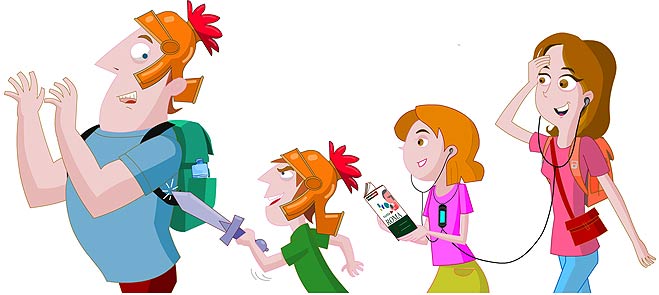
Some people think Rome isn’t exactly the best option for traveling with children. But if you plan it well, the trip can be a fascinating adventure for them too . Few cities can stimulate a child’s imagination as much as Rome, the setting for many of their favorite stories.
Undoubtedly, the trip has its perils: the tedious queues and long walks through the city could test their patience, and yours. But if you choose your cultural visits wisely and add a playful element , if you tell them the right story in the right place, and if you judiciously alternate between culture and entertainment, the trip to Rome could become a truly memorable experience for them… and Rome will be a place they’ll always want to return to.
All of this requires careful trip planning. In this section, we offer some tips that might help you with that task.
1. Discounts for children
Everywhere you go, there are discounts for children. Always ask at the ticket office about the “sconto bambini” (children’s discount) and have their age and ID ready. Here’s a table with the main discounts in Rome.
| PLACE | DISCOUNTS AND CONDITIONS | |
|---|---|---|
| Transportation | Subway and buses | 0-9 years, free |
| Trains (Trenitalia) | 0-3 years, free; 4-11 years, 50% discount | |
| Public monuments and museums | Municipal | 0-5 years, free. 6-25 years (EU*), reduced rate. Family rate: for each parent, two children under 18 years enter free. |
| State | 0-17 years, free. 18-25 years (EU*), reduced price. | |
| Vatican and others | Vatican Museums | 0-5 years, free. 6-18 years, reduced price.Families with children used to not have to wait in line. That’s no longer the case. To skip the line, you have to book online. |
| Ascent to the dome | Children free (ages unknown) | |
| Vatican Necropolis | Entry prohibited to children under 15 years of age (no exceptions) | |
| Catacombs | 0-6 years, free ; 7-15 years, reduced price |
(*) Only for citizens of the European Union (EU) and countries with reciprocal conditions.
Doubts about the Roma Pass
We answer two questions about the Roma Pass that are sometimes asked by those traveling with children:
1) Is it worth buying this card for children? No, tickets are usually free or reduced-price for them. Buying the Roma Pass for them is a waste of money .
2) If an adult buys the Roma Pass and therefore has priority entry without queuing (at the Colosseum, for example), can children enter with them skipping the queue? Yes, if the parents have the Roma Pass, the children also enter with priority entry along with them .
2. Tips for traveling with babies (0-2 years)
- Stroller, car seat, or baby carrier? Rome isn’t the best city for traveling with a stroller, but it’s manageable. You’ll sometimes have to walk along cobblestone streets and narrow, uneven sidewalks. At some monuments, you’ll also need to fold the stroller to go up stairs. The same applies to some metro stations, which don’t have elevators. So, if your baby is only a few months old, it will be more convenient to carry them in a carrier all day and leave the stroller at the hotel.
Here are some more specific details about the different monuments:- The ruins, like those in the Roman Forum or the Palatine Hill , are a bit awkward for strollers, but they don’t present any major problems. However, if you can use a baby carrier, all the better.
- The Colosseum can be visited comfortably: there are elevators and wide corridors.
- In other places, such as the Vatican Museums , paradoxically, bringing a stroller will make things easier, as you’ll be able to access them via alternative routes that avoid the crowds. If you bring a pram instead of a stroller, you’ll have to leave it behind, and they’ll provide you with a lightweight stroller.
- In St. Peter’s Basilica, they don’t allow chairs inside: you have to leave them in the cloakroom to the right of the facade (you pass by it when entering: there’s no problem finding it).
- You also can’t take chairs into the catacombs , obviously (since there’s no room), nor into the Galleria Borghese . You have to leave them in a cloakroom.
- Food and diapers. If you’re only staying a few days, it’s best to bring the baby food and diapers you’ll need from home. The brands and types of products you’ll find in Roman shops may be different from what you’re used to.
3. Tips for traveling with children
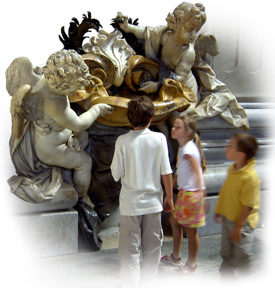
These tips are mainly aimed at those with children between 5-12 years old, who can begin to appreciate the interest of the different visits.
- Choose your visits wisely. In Rome, children can do a lot of fascinating things, such as exploring passageways, finding fountains with grotesque shapes on every corner, or colossal statues.Choose the monuments you’ll visit carefully, keeping in mind which ones they might enjoy most. And have some age-appropriate entertainment options ready for when they’re tired of sightseeing. We’ll give you some ideas in the next section.
- Prepare in advance and do some research. To keep the children from getting bored and tired quickly, the key is to motivate them properly and tell them the right story . If you can, read something about the places you’re going to visit. This will help you get them excited about those visits. Our Rome audio guide can help you with this.For example, before taking them to the Pantheon , have them see the nearby ruins of the four temples of Largo Argentina (on Corso Vittorio Emanuele). Explain that Rome has suffered countless fires and pillaging, and that after 2,000 years, the remains of ancient Rome are few and far between, often buried several meters below the current ground level. But there is one temple in Rome that is special. It is preserved intact, just as it was on the first day, with all its colorful marble on the walls and floor… Then take them under the circular dome of the Pantheon.
- Prepare them in advance and do some research. Before the trip, buy them an age-appropriate book about ancient Rome to help them get into the spirit. A children’s story about Julius Caesar, Claudius, Nero, the Colosseum… There are also comics set in ancient Rome, like Alix the Intrepid .They also really like the transparency books that show what Rome looked like in the past and what it looks like today. You’ll find them in many bookstores: one of the best on Rome’s monuments is the one at the Capitoline Museums, with its entrance on Piazza del Campidoglio .
- Emergency supplies. Having a deck of cards or a simple game handy can be a good idea. If they like to draw, bring paper and paints so they can draw a square, a column, or a fountain while you relax with a cappuccino .
 Years from now, those drawings will be a beautiful memory of your trip to Rome for them and for you.
Years from now, those drawings will be a beautiful memory of your trip to Rome for them and for you. - Don’t try to see everything. Your plan will have to combine the tastes of both adults and children, but the chain is only as strong as its weakest link, so you’ll need to frequently check in with them and take breaks when you see they’re getting tired. Flexibility and the ability to improvise are key. If you can’t see everything you planned, that’s perfectly fine. It’ll give you a good excuse to come back.
- Try to add a playful dimension to your visits. For example, when you’re out walking, have them look for ancient Roman columns embedded in or reused in other buildings. When you’re near the Trevi Fountain, let them search for the fountain itself, hidden among the narrow streets, so difficult to find. Or, organize a “monster hunt,” photographing your children next to all the monsters you find in Rome’s little fountains: they’re legion. Give them names, or discover their own ( you’ll find plenty of information and links here ).

- Buy them a souvenir : a small figurine, a bronze gladiator, or a legionary helmet—something of little monetary value but lasting value, so they can keep it for years as a memento of their visit to Rome.
- Be careful with your wallet. Finally, an important practical tip: when you’re on the subway or in a crowd, keep a close eye on your wallet. You’ll be so focused on not losing the children that you won’t think about anything else. Pickpockets know that families with children are easier targets. If your wallet is stolen, you could also have problems with your documents. It wouldn’t hurt to also carry your family record book and always leave it at the hotel.
4. Interesting monuments for children
In this section, we suggest some particularly interesting activities for children. Here are a number of ideas to help you plan your trip. First of all… the monuments! Rome’s main attraction, even for children, is its monuments. These are the ones we think they might enjoy the most:
- The Colosseum is spectacular, for both adults and children. In the surrounding area, you’ll often find people dressed as centurions or Roman soldiers, offering to take photos with them (important: agree on the price BEFORE taking the photo).
- St. Peter’s Basilica is equally impressive due to the sheer scale of everything, starting with the holy water fonts at the foot of the nave (see photo above). They also love the bronze statue of St. Peter with the worn foot, the dome seen from the inside, the enormous bronze baldachin… If they’re old enough, don’t miss climbing to the top of the dome : it requires a lot of effort, but the adventure and the view from the top will be one of their best experiences in Rome. Along the same lines, they might also really enjoy St. Paul Outside the Walls , for the monumental scale of the space.
- You have to see the Trevi Fountain both during the day and at night, and the famous coin-tossing ceremony, which guarantees a return visit to Rome, is a must for children. They’ll also love Piazza Navona , with its fountain full of monsters, and the Spanish Steps, especially if you find it bustling with people and adorned with flowers in spring. When it’s empty, it feels a bit deserted.
- Castel Sant’Angelo is full of passageways, staircases, courtyards, balconies with magnificent views of the surrounding area and its interior, and an enormous treasure chest… What more could you ask for to spark their imagination? If you do a little research beforehand about this unique place, which has served every imaginable purpose since its construction by Hadrian, you’ll make it a truly memorable visit.
- The Pantheon is a must-see. This incredible monument impresses both children and adults. A legend tells how such a large dome was built. Instead of using scaffolding and wooden supports, they raised a huge mound of earth, inside which they hid hundreds of gold coins. This way, no workers were needed to remove the earth. The emperor said that whoever found one of those coins could keep it, and within a few days all the earth had been removed.
- Some interesting views of the city might be very appealing to you: especially from the dome of St. Peter’s, as we have said, but also others such as those from the terrace of Castel Sant’Angelo, the Palatine Hill, etc.
- Take them also to the Bocca della Verità , so they can put their hand in the famous opening that suddenly closes on those who do not tell the truth.
- Trajan’s Markets are a labyrinth, with corridors, staircases and narrow galleries where you could have a great time.
- Finally, the Catacombs of the Appian Way . After the visit, you can take a nice break in the beautiful garden area along the Appian Way , or explore it by renting bicycles.
5. Other attractions for children
Here are some other activities that might be very appealing to young children.
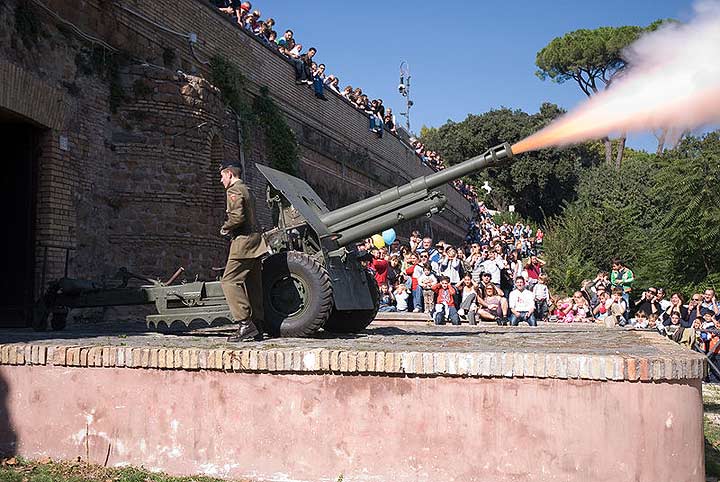
The Gianicolo canyon
It is fired every day at noon (without a projectile, of course, just a salvo). The custom was started by Pope Pius IX in 1849 to synchronize the bells of all the city’s churches. At that time, the cannon was located in Castel Sant’Angelo, but at the beginning of the 20th century, it was moved to the Janiculum Hill. The tradition of the cannon salute was interrupted (for reasons of prudence) during World War II and resumed a few years later. On calm days, the cannon shot can be heard throughout the center of Rome. The cannon is located almost at the foot of the statue of Garibaldi and is fired every day at noon.
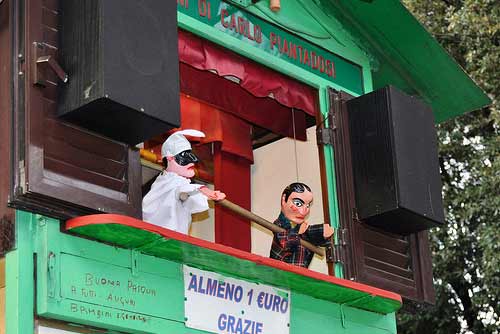
Gianicolo Puppet Theatre
This puppet theater is a true institution in Rome. The Piantadosi family has been delighting Rome’s children for almost a century with this little booth, which never moves from its spot. The gendarme, the devil, Punchinello, beautiful damsels… all modernized with contemporary characters. And always, plenty of whacks with sticks.
The puppet theater is located next to the Garibaldi statue, very close to the cannon. Performances are free; a donation of at least €1 is requested. Performance duration: 30 minutes. Schedule: Sundays, 10:30 a.m. to 12:00 p.m. (last performance, immediately after the cannon is fired). Saturdays: schedule varies; performances begin once a group has formed. Puppets are also available for purchase.
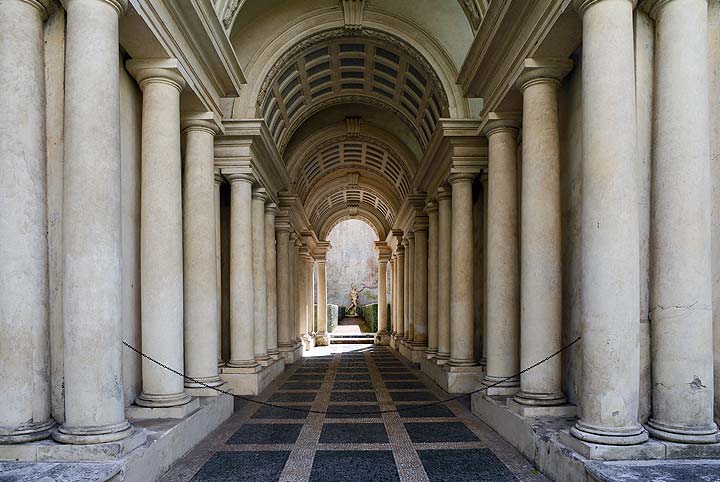
Visual deceptions
Rome is the city of the Baroque, the art of surprise, fantasy, and illusion. Here are three examples of amazing illusions that are easy to see and that children will love:
1) Borromini’s forced perspective in the Palazzo Spada : a gallery 9 meters long that appears to be 40 meters long. You can peek in and see it without paying the entrance fee.
2) The false dome painted in the church of San Ignacio , which can only be seen with correct perspective from a specific point in the church.
3) The Church of the Gesù , with its imposing vaulted ceiling. And next to it, the rooms of Saint Ignatius, with the trompe-l’œil frescoes in the galleries leading to them.
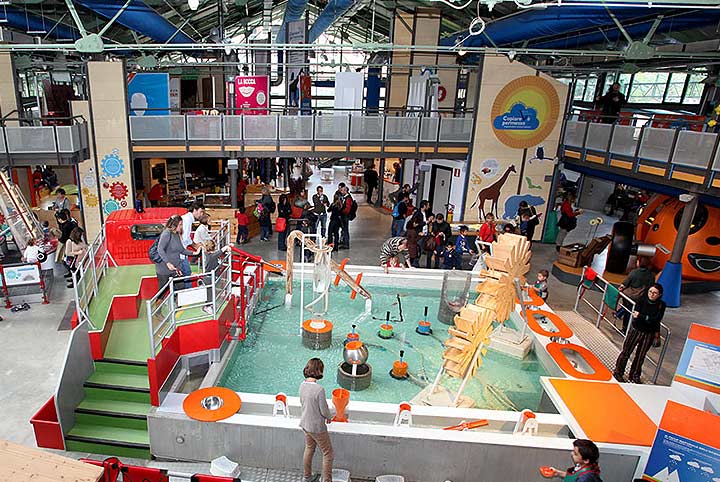
Explore. Children’s Museum
A recreation of a play city, tailor-made for young children, where everything can be seen, touched, and experienced. There’s a small village with a supermarket, trains, and fire trucks, for example. The tour lasts 1 hour and 45 minutes and is divided into several sections: science, society, food, robotics, and more. You must arrive at the starting point: tours begin at 10:00, 12:00, 15:00, and 17:00 . Designed for young children, up to 8-10 years old. Located near Piazza del Popolo. Explanatory signs are in Italian and English, but those who don’t speak these languages will also enjoy it. More information is available on their website: www.mdbr.it. You can watch this video demo on YouTube.
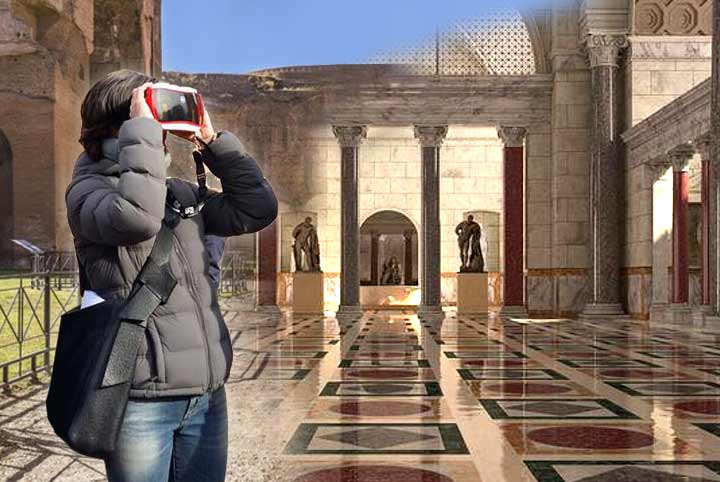
Virtual reality in Caracalla
Since 2017, the Baths of Caracalla have offered virtual tours that allow visitors to explore the thermal baths, reconstructing what this incredible complex, inaugurated by Caracalla in 216 AD, looked like. This visit can be especially appealing for adults and children. You can find up-to-date practical information on our opening hours and prices page .
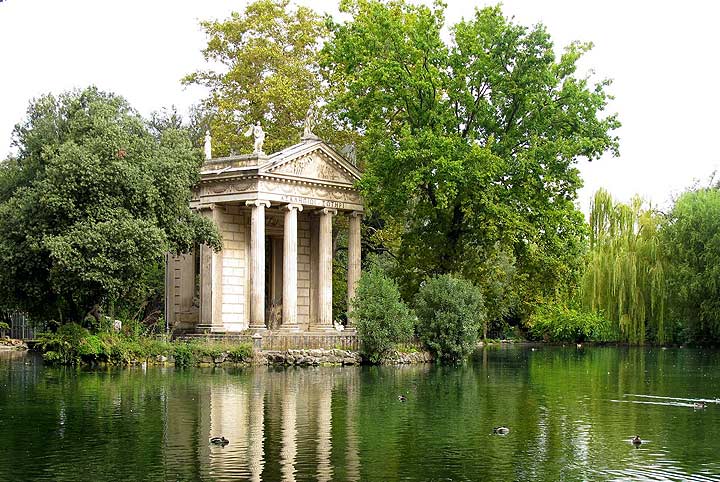
Villa Borghese Park
If the children start to tire of buildings and museums, Villa Borghese is a great place for outdoor recreation. It’s the second largest park in Rome, after Villa Pamphili. It features statues, fountains, reconstructions of classical temples, and small ponds with ducks, swans, and turtles.
The best area for children is around Porta Pinciana, where Via Veneto ends. There you can rent bicycles (as well as at many other stands in the park) and rowboats, and take a ride on a little train that tours the park. There’s even a small cartoon cinema ( Cinema dei Piccoli ), a wonderful municipal play center for children aged 3-10 ( Casina di Raffaello ), and a carousel. This little “green city” also has a zoo ( Bioparco ).
You can consult our map of Villa Borghese
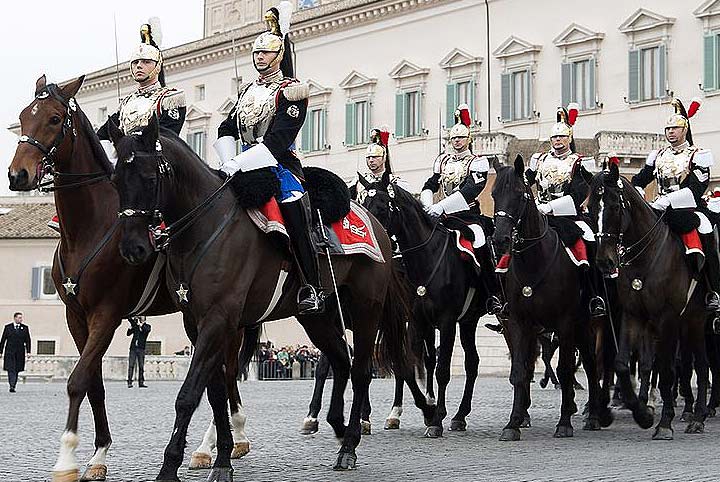
Changing of the guard at the Quirinal Palace
On Sundays , the changing of the guard ceremony takes place on the esplanade in front of the Quirinal Palace, the official residence of the President of the Republic. On other days, it is held inside the palace and cannot be seen. It is a very colorful ceremony that children will enjoy. The Quirinal Palace is a 5-minute walk from the Trevi Fountain. If you are in the area at that time, it’s worth taking a look. Winter schedule (October to June 2): Sundays at 4:00 p.m. Summer schedule (June 3 to September): Sundays at 6:00 p.m.
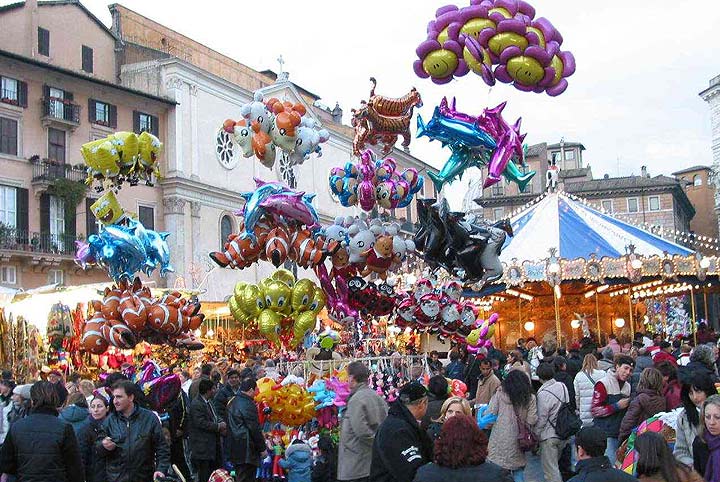
Christmas Market in Piazza Navona
For a century now, at the end of November, Piazza Navona has been filled with stalls of the Christmas market (also known as the Befana market), to the delight of children and adults alike. Toys, nativity scene figurines, Christmas decorations, all kinds of sweets, sugar coal… A traditional-style carousel is set up in the center of the square. This wonderful Christmas atmosphere lasts until January 5th, when Befana (the equivalent of the Three Wise Men) appears, a kind old woman who travels on a broomstick and hands out sweets to the children.
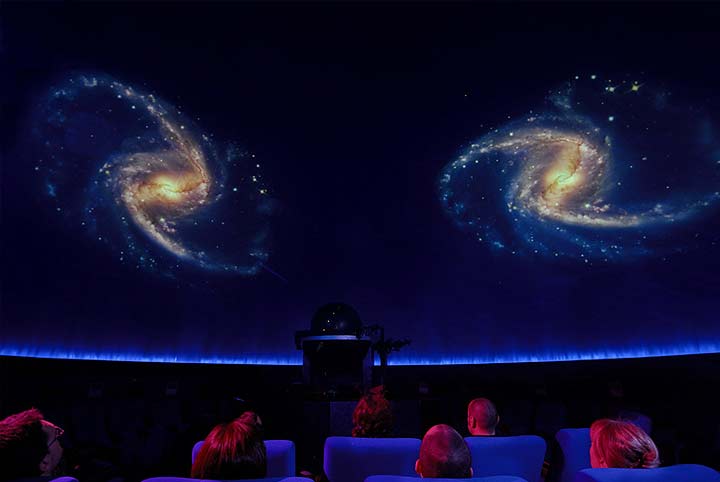
Planetary
Temporarily closed at its permanent location for restoration work, the planetarium continues to offer educational activities alongside the Zoology Museum at Villa Gorghese. More information: www.planetarioroma.it
Opened in 2004, the planetarium features a 14-meter-diameter dome that projects a view of the sky. In addition to various exhibition halls, shows are held every hour and a half.
Location: Piazza G. Agnelli 10 (EUR district, far from the city center). The planetarium is located in the same building as the Museum of Roman Civilization . Closed on Mondays .
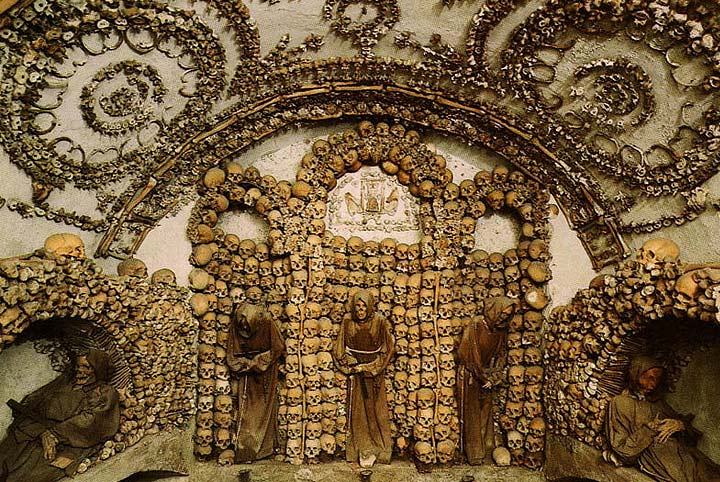
Capuchin crypt. We advise against it.
It consists of several rooms decorated with the bones of thousands of capuchin monks: femurs, skulls, complete skeletons… Many recommend it as an attractive visit for children, but it is a truly macabre place, whose damp, oppressive atmosphere turns the stomach of many adults. A good place to meditate on the fleeting nature of life, but not for entertaining children.
Is our audio guide suitable for children?
Many people have told us that their young children listened with interest to the tracks on our Rome audio guide . The testimonials we have are from children aged 9-10 and up. It’s certainly not suitable for younger children.
Here you can see some excerpts from reviews of those who have used the audio guide with children .
6. Frequently Asked Questions
These are some frequently asked questions about children in Rome. If you have any further questions, please contact us by email.
If the parent has a Roma Pass, would everyone be entitled to priority entry without queuing, or do the children have to go to the ticket office?
If the parents have the Roma Pass (with skip-the-line entry) and the children enter for free, everyone can skip the line and go directly to the entrance.
But if you have to pay the reduced rate, it’s best to queue (if it’s not too long) or ask at the ticket office beforehand.
For a family consisting of at least one parent and two children under 18, would they have access to the monuments without having to get tickets for the children?
State-run monuments and museums are free for those under 18. Therefore, for them the answer is obvious: they get in free in any case.
Municipal Monuments and Museums have a reduced rate for children from 6 years old, but they have a “family rate”: one of the parents accompanied by one or two children under 18 years old pay only one entrance fee.
It is not necessary to get tickets for minors: they enter with the same ticket as their father or mother.

